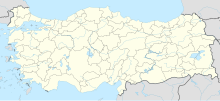Komana Pontika
Coordinates: 40 ° 21 ′ 26.6 ″ N , 36 ° 38 ′ 19.3 ″ E

Komana Pontika ( Greek Κόμανα Ποντικά ; Latin Comana Pontica ) is the name of an ancient city in the landscape of Pontos in Asia Minor . It was located in the valley of the Iris River , which is now called Yeşilırmak , 11 km above Tokat on the road to Niksar near today's village of Gümenek . In its Latin spelling Comana Pontica , it is also the name of a titular bishopric of the Catholic Church.
Like its sister city Komana in Cappadocia, Komana Pontika was the seat of a temple state, whose high priest came in rank immediately after the king of Pontus. The city was a center of the orgiastic cult of the war goddess Enyo , who was called Ma there . According to Strabo , among whose ancestors there was a high priest from Komana, there were more than 6,000 temple servants ( hierodules ) who worked for the priest of a temple equipped with large estates.
Gnaeus Pompeius Magnus enlarged the temple state, which was connected with extensive political sovereignty, to a radius of 600 stadiums (approx. At Archelaos . This high priest Archelaos later married the Egyptian ruler Berenike IV and became Pharaoh of Egypt for six months. He was followed in the office of high priest by his son of the same name , who, however, was deposed by Gaius Iulius Caesar as part of a reorganization of the political situation. His son, also named Archelaos , was born by Mark Antony in 36 BC. Appointed king of Cappadocia .
Independent until the early Roman Empire, Komana became part of the province of Galatia with the additional name Hierokaisareia in 34/5 AD . In late antiquity, Komana Pontika was the seat of a diocese. John Chrysostom died there on his way back from exile in Armenia to Constantinople .
On the hill of the settlement on which the temple of the goddess was located, apart from the sparse remains of the fortification walls, hardly any buildings can be made out.
Hugo Winckler identified the city with the Hittite Kummani , today people tend to equate this with Komana in Cappadocia .
literature
- Luigi Polacco : Comana Pontica. Rapporto esplorativo. In: Atti del Istituto Veneto di Scienze, Lettere ed Arti , Volume 150, 1991-92, pp. 1-7.
- Bernard Rémy, Michel Amandry: Comana du Pont, sous l'Empire romain. Étude historique et corpus monétaire. Milan 1999, ISBN 88-87235-04-X .
- David Raoul Wilson: Comana Pontica, Pontus, Turkey . In: Richard Stillwell et al. a. (Ed.): The Princeton Encyclopedia of Classical Sites. Princeton University Press, Princeton NJ 1976, ISBN 0-691-03542-3 .
- Ali Özçağlar: The Ancient Settlements in Kazova and its Surroundings , tucaum.ankara.edu.tr
Remarks
- ↑ In this Antitaurus are deep and narrow valleys, in which are situated Comana and the temple of Enyo, whom the people there call "Ma." in: Strabo, Geography, Book 12 , perseus.tufts.edu
- ^ Strabo, Geographica 12, 3, 33.
- ↑ Strabo 17, p. 796.
